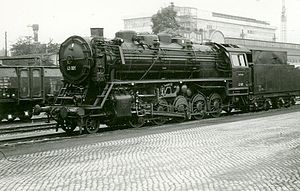- DRG Class 43
-
DRG Class 43 Number(s): DRG 43 001–035 Quantity: 35 Manufacturer: Henschel, Schwartzkopff Year(s) of manufacture: 1926–1928 Retired: 1968 Wheel arrangement: 2-10-0 Axle arrangement: 1'E Axle arrangement: 1'E h2 Type: G 56.20 Gauge: 1,435 mm Service weight: 110.8 t Adhesive weight: 96.6 t Axle load: 19.3 t Top speed: 70 km/h Indicated Power: 1,383 kW Driving wheel diameter: 1,400 mm Leading wheel diameter: 850 mm Valve gear: Walschaerts (Heusinger) No. of cylinders: 2 Cylinder bore: 720 mm Piston stroke: 660 mm Boiler Overpressure: 14 bar Grate area: 4.73 m² Superheater area: 100.00 m² Evaporative heating area: 237.10 m² Tender: 2'2' T 32 Water capacity: 32.0 m³ Fuel: 10.0 t coal The German locomotives of DRG Class 43 were standard (see Einheitsdampflokomotive) goods train engines with the Deutsche Reichsbahn.
This was the second class that was built on the Einheitslok principle. According to the first classification scheme of the DR's Standardisation Bureau, 2-10-0 goods train locomotives were to be procured with a 20 ton axle load. To achieve this a two-cylinder class (the Class 43) and a three-cylinder class (the Class 44) were envisaged, because it was not yet known which configuration would be more economical. Ten examples of each class were procured in parallel. The Class 43 was supplied by Henschel and by Schwartzkopff.
In trials it was discovered that the Class 43 was more economical to operate at powers under 1500 PSi. As a result, a further 25 examples of the 43 were ordered up to 1928. However, due to the increase in goods train speeds in the 1930s, the Class 44 was given priority thereafter because, in addition to its economy when running at higher speeds and the better running qualities of its three-cylinder driving gear, it was also cleared for running at up to 80 km/h.[1] As a result no more Class 43s were ordered.
In the literature statements are often found that the locomotive was not sufficiently powerful overall. In response to that, number 43 013 was loaded for testing purposes with a train of 5000 tons - that is more than twice that given in the haulage tables - and headed it without complaint. In doing so, 43 013 is a record holder. Never before or since has any German locomotive hauled such a load.[2]
The Class 43s, which had operating numbers 43 001 - 43 035, all remained with the DR in East Germany after the Second World War. In 1960, the remaining engines were once again modernised, the powerful boiler even enabled goods trains greater than the maximum allowable load to be hauled. This led, however, to frame damage, that the Reichsbahn could not repair. So the machines were rapidly retired, the last one being taken out of service in 1968 at Cottbus locomotive depot. Locomotive 43 001 became a museum locomotive and belongs to the Dresden Transport Museum, but is presently in the Saxon Railway Museum, a former home depot of the Class 43.
The engines of this class were equipped with a 2'2' T 32 tender.
References
- ^ Hans Wiegard: Fahrzeugporträt Baureihe 43: 5000 Tonnen am Haken, in Lok Magazin 8/2004, S.41
- ^ Hans Wiegard: Fahrzeugporträt Baureihe 43: 5000 Tonnen am Haken, in Lok Magazin 8/2004, S.42
See also
External links
- There is a relevant English-language forum at Railways of Germany
Classes of Deutsche Reichsbahn locomotive Express train tender locomotives Passenger train tender locomotives Goods train tender locomotives Passenger tank locomotives Goods tank locomotives Rack railway, branch line & narrow gauge locomotives Electric locomotives Diesel locomotives Railbuses and multiple units State railway locomotive lists Categories:- Steam locomotives of Germany
- 2-10-0 locomotives
- Deutsche Reichsbahn-Gesellschaft locomotives
- Henschel locomotives
- Railway locomotives introduced in 1926
Wikimedia Foundation. 2010.

